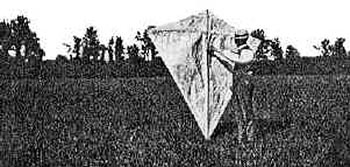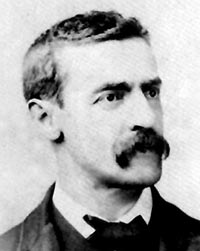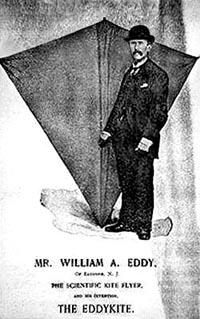
William A. Eddy
William Eddy, a journalist from New Jersey, was motivated by the desire to lift meterological and photographic equipment, for which he needed a good steady flyer. He seems to have been aware of the existance of bowed kites from Java (the Malay kite) but, being unable to obtain reliable information about them, reinvented the form himself. His kite rapidly superceeded McAidie's flat barn door kite for meterological purposes.
 William Eddy and his bowed kite
In particular, Eddy's kite had a bowed cross-spar and a loose sail, the sail folding back against the spine so as to form a keel at its lower end. This also aided stability, but Eddy's seminal contribution was that he was apparently the first person to explain (and so exploit) the stabilising effect of a bow or dihedral.
by Andrea Casalboni During the month of May of 1895, the American journalist William Eddy, who patended a kite with his name, obtained the first aerial pictures from the New World, lifting a 9x9 cm. format camera, using a train of dihedral kites in the shape of lozenges. During the month of August of 1896 he gained other good results using an early model of KODAK camera lifted at an eight of about 400 meters. Using a train of three kites on May 9, 1897, Eddy took 24 images from various eights between 390 and 420 meters.
by Andrea Casalboni
Eddy Kite (replica) William Eddy, a journalist from New Jersey, contributed a great deal to western kite development and he made extensive experiments raising photographic and meteorological equipment. In the 1890's, Eddy developed an efficient, stable, cruciform-shaped kite, able to be flown without a tail. By using a flexible crosspiece (spar), the kite would bow in the wind thus acting like a ship's keel in water. The loose cover would also billow upwards, acting to some extent as an airfoil, giving additional lift.
Kites and Meteorology...from "Physics in Canada" In 1894 William A. Eddy, a journalist and kite designer from New York, came to Blue Hill for the purpose of lifting instruments into the lower atmosphere with his kites [9]. A lightweight thermograph weighting 1.1 kg was constructed with a basket placed over the instrument to screen the sensor from radiation. On August 4, 1894, using a series of five Malay tailless kites, the thermograph was carried aloft to an altitude of 427 m, as measured by optical theodolites 100 m apart. The 4 hr continuous recording of temperature obtained from this flight was the first of its kind in the world, marking the start of worldwide pressure, humidity, and sometimes wind soundings of the atmosphere.
|
© Copyright 1999-2002 CTIE - All Rights Reserved - Caution |

